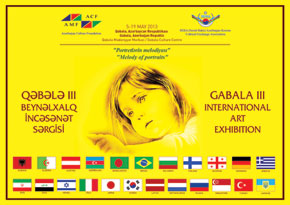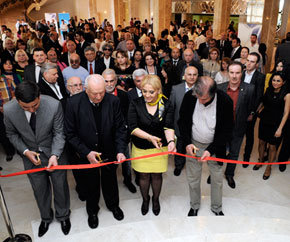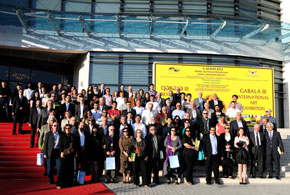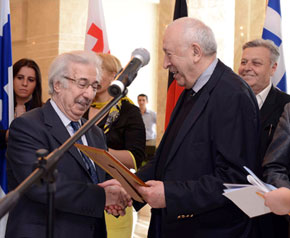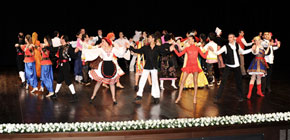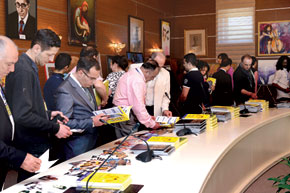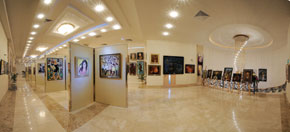The town of Qabala in the foothills of the Caucasus has hosted its third International Art Exhibition, this year entitled Portrait Melody. Organized by the SEBA (Seoul-Baku) Azerbaijan-Korean Cultural Exchange Association and Azerbaijan Culture Foundation, the exhibition was dedicated to the 90th anniversary of the birth of the late Azerbaijani president, Heydar Aliyev.
Interest in the Qabala exhibition is growing. The first exhibition in 2010 featured work from 14 countries and the next year from 18. This year, 23 countries were represented at the exhibition. Some 300 works by nearly 160 artists were on display. Renowned Azerbaijani artist Tahir Salahov, who has been awarded the honorary titles People’s Artist of Azerbaijan, Russia and the USSR, led the professional jury. The jury awarded diplomas to local and foreign artists for artistic and aesthetic merit, originality and individuality. Twenty-two awards were presented, while honorary diplomas were given to Leyla Aliyeva for her contribution to promoting the rich cultural heritage and national values of Azerbaijan and to Ottoman Prince Harun Abdulkerim Osmanoglu, who was the honorary guest at the exhibition. The awards were presented on the opening day of the exhibition, 5 May, at the Qabala Cultural Centre.
Cultural exchange and dialogue are an important feature of the exhibition, and were appreciated by artists, officials and diplomats in their opening ceremony speeches.
From the letter of Mehriban Aliyeva, President of the Azerbaijani Culture Foundation, UNESCO and ISESCO Goodwill Ambassador
Interactions among world cultures play a great role in public and political processes and inter-civilizational dialogue all the time. Azerbaijan, which has contributed to the development of intercultural dialogue through the centuries, has historically promoted the mutual enrichment of the culture and art of different nations and the strengthening of unity among nations.
Recently, Azerbaijan has hosted many international music and art festivals, conferences and exhibitions. International cultural relations and mutual integration are priorities in Azerbaijani’s policy. The 3rd Qabala International Art Exhibition, which is now a regular event, also serves to preserve our cultural heritage, improve the arts, enable an exchange of practice in the arts and expand international relations and intercultural dialogue.
Farhad Khalilov, Chairman of the Azerbaijan Artists’ Union
What’s most important for artists is to exchange ideas with one another, to measure their works against each other and improve, and to share their love for art. SEBA’s involvement and annually expanding initiatives show that their interest is real and not just a formality, which pleases artists.
Choi Suk-Inn, Ambassador of the Republic of Korea to Azerbaijan
It’s well known that Azerbaijan has a rich cultural heritage on the Silk Road, and has promoted intercultural dialogue, contributing to the sharing of culture and art among different nations. I hope that this 3rd Exhibition will be a wonderful arena to share opinions, passions and love of art and culture among participants from various countries and, at the same time, serve as an opportunity to enhance mutual understanding among nations.
Ruhangiz Heydarova, Chairwoman of SEBA
Every artwork displayed in the Portrait Melody Exhibition has its own beauty, colour and content. And each of them is unique in terms of style. I believe the exhibitors will acquaint us with their nations’ inner world through their artworks. And the exhibition will have a positive impression on the exhibitors and inspire them with new ideas. This is evidence that they are ready for any innovation in the fields of rich, diverse contemporary art and culture.
Tahir Salahov, People’s Artist of Azerbaijan, Russia and the USSR
Qabala is already known as one of the cultural centres of Azerbaijan and it is very gratifying that Qabala hosts the exhibition annually. I’m sure that such events will help to improve cultural exchange among Azerbaijani and foreign artists, and that artists will be inspired by the beautiful scenery and historic sites of Qabala.
Inspired by Azerbaijan
But what did the exhibitors themselves make of the event? Usually held in chilly December, this year’s exhibition took place in warm, sunny May amidst the region’s mountain scenery. The timing and the venue were just right. Exhibitors and visitors enjoyed a diverse cultural programme; they were taken to the historic and cultural sites of Qabala, found out about local industry at the Beltmann Piano factory, Jale cannery, cattle farm and so on. They could even try rope rides in the unspoilt mountains, stroll through green meadows, visit archaeological digs, try their hand at shooting. In other words, they enjoyed a wealth of experiences and impressions.
As the artists talked to Visions, it turned out that many of them had imagined Azerbaijan to be very different. One young artist was extravagant Ukrainian painter Darya Babich. She brought three paintings, one of which, Inspired Memory, won the Expressive Portrait category. Local artists described Darya’s work as original, different from others at the exhibition.
Having come from a country with Slavic culture, Darya was inspired at first sight by the Eastern beauty of Baku and the scenery of Qabala. Her subjects are closely related to the philosophy of human relations, and she hopes now to generate new ideas concerning the relations between nature and man.
The first thing that struck me here in Azerbaijan was the structure of the capital Baku and the colourful scenery of Qabala region. Those bionic forms of Baku just captivated me too. Before coming to Azerbaijan I had imagined a very different place. Too many emotions.
You paint human stories a lot. As an artist, how would you portray Azerbaijani people in your work?
I would use bright, contrasting colours. I don’t know why but I mostly see blue and red. For me blue is associated with the depth of the Azerbaijani people, so I would use it a lot in paintings. And red is associated with passion. Depth and passion – I would rather describe Azerbaijani people that way.
What did you notice about the painting style of Azerbaijani artists?
I noticed that along with bright colours they use details and patterns so characteristic of Azerbaijani culture and traditions. I often saw those patterns in your carpets, clothes and other things. It is all so delicate. I would say the details play a huge role in everything. For instance, if we wear a nice dress it is unique and more attractive if we add beads, a scarf or hat. It is the same with painting.
What will you most remember from this trip?
Along with the emotions connected with these places and people, I especially feel full of respect for the foreign exhibitors. Personally, I was very impressed with the Ukrainian dance on the stage of the Qabala Cultural Centre during the opening ceremony. I cannot express all my feelings. Thanks a lot!
The opening ceremony concert deserves a special mention. It was a great show given by an Azerbaijani team of professional dancers and singers. The programme was opened by promising rock singer Latifa Soyuoz, who was followed by an Iranian singer. The duet of Azerbaijani opera divas Fidan and Khuraman Gasimova created a wonderful atmosphere for the concert which was rounded off with dance. Dance elements from all 22 countries visiting the exhibition were included.
Iwasaki Nagi, a young, smiling painter from Japan, also liked the idea of the dance performance and thanked the organizers, especially SEBA. Iwasaki’s The Bowl Ship of Sado: Guggenheim for All People won in the category Original Depiction of a Complicated Theme. In his water colours Iwasaki often returns to the themes of the sea and fishing.
The part of Japan where I’m from is famous for fishing. So, in my works you can often find all things related to fish and the sea. Ordinary people and their dreams are also often seen in my paintings. The message of this painting is the hope that has always existed in the hearts of ordinary people.
Tatiana Aliyeva is an artist from Singapore, who was originally from Azerbaijan. It’s already 20 years since she moved to Singapore with her family. However, at least once a year Tatiana comes back to Baku for a month, where she visits the studios of her artist friends to paint. But the painting that won her the prize in the category Original Description of a Musical Composition she created in Singapore.
My husband plays the violin. So when I heard about this exhibition I decided to paint something from the musical world and thought why not paint the violin that I often see at home. And I was so pleased to be here among these great artists within their fine works at the exhibition. They are all so different and each of them is unique.
Alla Dzevaltovska from Latvia was very surprised to win the Complex Image category with her painting Grandpa. She confessed that she doesn’t specialize in portraits and has just a small number of portraits, including this one of her grandfather.
To be honest, I didn’t expect to win. I’m so happy. As you can see, I use bright colours a lot; I like blue very much and think I’ll use it to paint Qabala’s mountains. They are so beautiful.
It was a first visit to Azerbaijan for Turkish artist Musa Balan, who presented two water colours at the exhibition. Unlike his Ukrainian counterpart Darya Babich, he saw the country mainly in green. And that wasn’t surprising! The Azerbaijani flag has three colours – blue, red and green! And that was how the country was seen in the eyes of foreigners. The Turkish artist appreciated the organization of the exhibition and expressed his thanks to everyone who made it happen.
It was so great to be here and present our works at the exhibition dedicated to the 90th anniversary of the birth of national leader Heydar Aliyev. It was an amazing event! I really loved your country, your capital and people.
What would you paint here in Azerbaijan? What drew your attention the most?
I would paint Baku in the context of history but with a touch of modernity. I saw a lot of old buildings here with their hidden mysteries and new ones which even set off the mystique of the city. Azerbaijan has a deep history without any doubt. Actually, I visited Martyrs’ Avenue on the first day of my trip. I was shocked by the hundreds of graves of innocent victims of 20 January who gave their lives for Azerbaijan’s independence. And that’s a part of Azerbaijan’s history I would like to perpetuate in my paintings. Also I’m going to paint the Maiden Tower and Boulevard which impressed me with their beauty and character. In a nutshell, I could do enough paintings to fill the entire exhibition.
Is there any difference in attitude towards art in Azerbaijan and your country Turkey?
Here I found great respect for art and artists. Especially I met many female artists. I think the role of the First Lady, Mehriban Aliyeva, in the development of ties with culture and art is obvious. I noticed that there were many oil paintings exhibited here in Qabala. Only a few pieces, including mine, were water colours. I have seen a large number of very good paintings by Azerbaijani artists here. I can say that art is well developed here. In Turkey it is also developed, especially water colours.
Which Azerbaijani artists did you meet? Did you know anybody before?
I was glad to meet professional Azerbaijani artists. I had heard a lot about Tahir Salahov, the People’s Artist of Azerbaijan, Russia and the USSR, and finally I got the opportunity to shake his hand. I really like his work. I also met Farhad Khalilov, Sakit Mammadov, Isa Mammadov, Mirnadir Zeynalov, Darya Babich, Khanlar Asadullayev, Rena Mammadova and other artists. They all made a very good impression on me. I would like to keep on coming here again and again…
